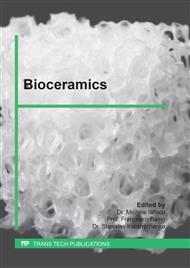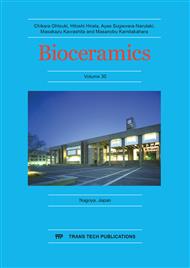[1]
S.R. Knight, R. Aujla, S.P. Biswas, Total Hip Arthroplasty-over 100 years of operative history, Orthopedic reviews 3.2 (2011).
Google Scholar
[2]
P.S. Christel, Biocompatibility of surgical-grade dense polycrystalline alumina, Clinical orthopaedics and related research, 282 (1992) 10-18.
DOI: 10.1097/00003086-199209000-00003
Google Scholar
[3]
Australian Orthopaedic Association National Joint Replacement Registry, Annual Report 2015. Available at: https://aoanjrr.sahmri.com/documents/10180/217745/Hip%20and%20Knee% 20Arthroplasty.
Google Scholar
[4]
Swedish Hip Arthroplasty Register, Annual Report 2013. Available at: https://registercentrum.blob.core.windows.net/shpr/r/Annual-report-2013-HJnnK8Tie.
Google Scholar
[5]
The New Zealand Joint Registry, Fifteen Year Report: January 1999 to December 2013. Available at: https://nzoa.org.nz/system/files/NZJR2014Report.pdf.
Google Scholar
[6]
National Joint Registry for England, Wales, and Northern Ireland: 11th Annual Report: 2014. Available at: http://www.njrcentre.org.uk/njrcentre/Portals/0/Documents /England/Reports/11th_annual_report/NJR%2011th%20Annual%20Report%202014.pdf.
Google Scholar
[7]
G. Willmann, Improving bearing surfaces of artificial joints, Advanced Engineering Materials, 3.3 (2001) 135-141.
DOI: 10.1002/1527-2648(200103)3:3<135::aid-adem135>3.0.co;2-b
Google Scholar
[8]
H.J. Cho, W.J. Wei, H.C. Kao, C.K. Cheng, Wear behavior of UHMWPE sliding on artificial hip arthroplasty materials, Materials chemistry and physics, 88.1 (2004) 9-16.
DOI: 10.1016/j.matchemphys.2003.10.021
Google Scholar
[9]
R.C. Dante, C.K. Kajdas, A review and a fundamental theory of silicon nitride tribochemistry, Wear 288 (2012) 27-38.
DOI: 10.1016/j.wear.2012.03.001
Google Scholar
[10]
E.M.B. Del Prever, A. Bistolfi, P. Bracco, L. Costa, UHMWPE for arthroplasty: past or future?, Journal of Orthopaedics and Traumatology 10.1 (2009) 1-8.
DOI: 10.1007/s10195-008-0038-y
Google Scholar
[11]
G. Pezzotti, S.B. Bal, E. Casagrande, N. Sugano, B.J. McEntire, W. Zhu, L. Puppulin, On the molecular interaction between femoral heads and polyethylene liners in artificial hip joints: phenomenology and molecular scale phenomena, Biomedical Materials, 12.1 (2016).
DOI: 10.1088/1748-605x/12/1/015005
Google Scholar
[12]
S. Affatato, B. Bordini, C. Fagnano, P. Taddei, A. Tinti, A. Toni, Effects of the Sterilisation Method on the Wear of UHMWPE Acetabular Cups Tested in a Hip Joint Simulator, Biomaterials, 23.6 (2002) 1439-1446.
DOI: 10.1016/s0142-9612(01)00265-4
Google Scholar
[13]
G. Pezzotti, Raman Spectroscopy of Biomedical Polyethylenes, Acta biomaterialia 55 (2017) 28-99.
DOI: 10.1016/j.actbio.2017.03.015
Google Scholar
[14]
S.M. Kurtz, O.K. Muratoglu, F.J. Buchanan, B. Currier, R. Gsell, F.W. Shen, S.S. Yau, Interlaboratory studies to determine optimal analytical methods for measuring the oxidation index of UHMWPE, Biomaterials 22.21 (2001) 2875-2881.
DOI: 10.1016/s0142-9612(01)00033-3
Google Scholar
[15]
D.E. King, W.E. Swartz, Variable-angle X-ray photoelectron spectroscopic determination of the thickness of the oxide layer on aluminum metal: An advanced undergraduate laboratory experiment, Journal of Chemical Education 64.11 (1987) 981.
DOI: 10.1021/ed064p981
Google Scholar
[16]
C.D. Wagner, D.E. Passoja, H.F. Hillery, T.G. Kinisky, H.A. Six, W.T. Janser, J.A. Taylor. Auger and photoelectron line energy relationships in aluminum–oxygen and silicon–oxygen compounds, Journal of Vacuum Science and Technology 21.4 (1982).
DOI: 10.1116/1.571870
Google Scholar
[17]
J.R. Lindsay, H.J. Rose, W.E. Swartz, P.H. Watts, K.A. Rayburn, X-ray photoelectron spectra of aluminum oxides: structural effects on the chemical shift,, Applied Spectroscopy 27.1 (1973) 1 - 5.
DOI: 10.1366/000370273774333876
Google Scholar
[18]
B.G. Draeger, G.P. Summers, Defects in Unirradiated α-Al2O3, Physical Review B 19.2 (1979) 1172.
Google Scholar
[19]
K.H. Lee, J.H. Crawford, Luminescence of the F Center in Sapphire, Physical review B 19.6 (1979) 3217.
Google Scholar
[20]
G. Pezzotti, E. Marin, T. Adachi, A. Rondinella, F. Boschetto, W. Zhu, N. Sugano, R.M. Bock, B. McEntire, S.B. Bal, Bioactive silicon nitride: A new therapeutic material for osteoarthro-pathy, Scientific Reports 7 (2017) 44848.
DOI: 10.1038/srep44848
Google Scholar
[21]
T. Sekiguchi, K. Sumino, Cathodoluminescence study on dislocations in silicon, Journal of applied physics, Journal of applied physics 79.6 (1996) 3253-3260.
DOI: 10.1063/1.361271
Google Scholar
[22]
I..J. Leslie, S. Williams, G. Isaac, E. Ingham, J. Fisher, High Cup Angle and Microseparation Increase the Wear of Hip Surface Replacements, Clinical Orthopaedics and Related Research® 467.9 (2009) 2259-2265.
DOI: 10.1007/s11999-009-0830-x
Google Scholar
[23]
C. Kajdas, General Approach to Mechanochemistry and Its Relation to Tribochemistry, Tribology in engineering, InTech, (2013).
DOI: 10.5772/50507
Google Scholar



